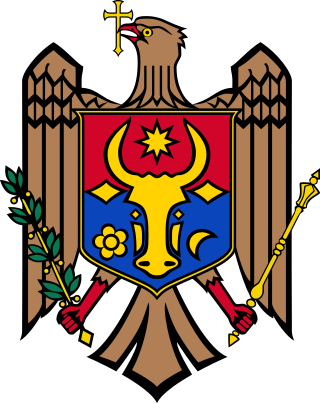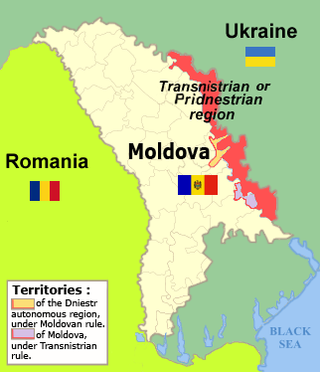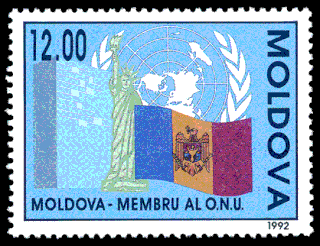
The politics of Moldova take place in a framework of a parliamentary representative democratic republic, wherein the prime minister is the head of the Government of Moldova, and a multi-party system. The President of Moldova has no important powers. The government exercises executive power while the legislative power is vested in the Parliament. The judiciary is independent of the executive and the legislature. The position of the breakaway region of Transnistria, relations with Romania and with Russia, and integration into the EU dominate political discussions.

After achieving independence from the Soviet Union, the Republic of Moldova established relations with other European countries. A course for European Union integration and neutrality define the country's foreign policy guidelines.

Transnistria, or Pridnestrovie, officially known as the Pridnestrovian Moldavian Republic (PMR), is a breakaway state internationally recognized as part of Moldova. Transnistria controls most of the narrow strip of land between the Dniester river and the Moldova–Ukraine border, as well as some land on the other side of the river's bank. Its capital and largest city is Tiraspol. Transnistria is officially designated by the Republic of Moldova as the Administrative-Territorial Units of the Left Bank of the Dniester or as Stînga Nistrului.

The Transnistria conflict is an ongoing frozen conflict between Moldova and the unrecognized state of Transnistria. Its most active phase was the Transnistria War. There have been several attempts to resolve the conflict, although none have been successful. The conflict may be considered as having started on 2 September 1990, when Transnistria made a formal sovereignty declaration from Moldova.
The 2006 Transnistrian customs crisis started on March 3, 2006, when Ukraine imposed new customs regulations on its border with Moldova on the Transnistrian region by declaring that it will only import goods from Transnistria with documents processed by Moldovan customs offices, as part of the implementation of a joint customs protocol between Ukraine and Moldova on December 30, 2005.

This is the history of Transnistria, officially the Pridnestrovian Moldavian Republic (PMR), an unrecognised breakaway state that is internationally recognised as part of Moldova. Transnistria controls most of the narrow strip of land between the Dniester river and the Moldovan–Ukrainian border, as well as some land on the other side of the river's bank.
The 1997 Moscow memorandum, also known as the Primakov memorandum, was an agreement governing relations between Moldova and Transnistria aimed at solving the Transnistria conflict.

A double referendum was held in Transnistria on 17 September 2006. Voters were asked whether they approved of the possibility of renouncing independence and integration with Moldova, or alternatively independence and a possible future integration into the Russian Federation.

The Russian Federation holds an unknown number of soldiers in Transnistria, an unrecognized breakaway state internationally recognized as part of Moldova. This Russian military presence dates back to 1992, when the 14th Guards Army intervened in the Transnistria War in support of the Transnistrian separatist forces. Following the end of the war, which ended in a Russian-backed Transnistrian victory and in the de facto independence of the region, the Russian forces stayed in a purportedly peacekeeping mission and reorganized in 1995 into the Operational Group of Russian Forces (OGRF), currently guarding the Cobasna ammunition depot. Some other Russian soldiers also participate in the Joint Control Commission between Moldova, Russia and Transnistria since 1992.

The European Union Border Assistance Mission to Moldova and Ukraine was launched in 2005. It promotes border control, customs, and trade norms and practices that meet European Union standards and serve the needs of its two partner countries. It is an advisory, technical body based in Odesa, Ukraine. It has a Liaison Office in Chișinău, Moldova, and six field offices; three on the Moldovan side of the joint border and three on the Ukrainian side. EUBAM activities are intended to promote economic development and enhance regional security. The Mission contributes to cross-border cooperation and confidence building, helping to improve efficiency, transparency, and security along the Moldova–Ukraine border.

The following is timeline of the History of independent Moldova which started after the independence of Moldova.

Parliamentary elections were held in Transnistria on 12 December 2010. All 43 seats of the Supreme Council of Transnistria were up for election. Transnistria uses first past the post with 43 single seat constituencies.

Moldova–Transnistria relations are the political and economic relations between the Republic of Moldova and Transnistria, an unrecognized state between the Dniester River and Ukraine. During the dissolution of the Soviet Union, political tensions in the Moldavian Soviet Socialist Republic led to Transnistria declaring independence from Moldova, culminating in the Transnistrian War of 1992. As part of the ceasefire agreement ending the war, a Joint Control Commission composed of Moldovan, Transnistrian, and Russian forces was established to supervise the demilitarized zone which was located in the Transnistrian region. The Joint Control Commission still supervises the zone, and negotiations to resolve the dispute are ongoing. The negotiations are supported by the Russian Federation, Ukraine, the United States, the European Union, and the Organization for Security and Co-operation in Europe (OSCE).

Russia–Transnistria relations are the bilateral relations between the Pridnestrovian Moldavian Republic (Transnistria), an unrecognised breakaway state that is internationally recognised as part of Moldova, and the Russian Federation. Russia does not officially recognise the independence of Transnistria; nevertheless, Russia maintains special relations with Transnistria in the political, military, cultural, and economic spheres.

Transnistria–Ukraine relations is the bilateral relationship between the Pridnestrovian Moldovan Republic and Ukraine. Ukraine does not officially recognize the independence of Transnistria. Nevertheless, it maintains special relations with Transnistria in the political, cultural and economic spheres.

Since the dissolution of the Soviet Union in 1991, Russia has been involved in territorial disputes with a number of other post-Soviet states. These disputes are primarily an aspect of the post-Soviet conflicts, and have led to some countries losing parts of their sovereign territory to what a large portion of the international community designates as a Russian military occupation. As such, these lands are commonly described as Russian-occupied territories, regardless of what their status is in Russian law. The term is applied to Georgia, Moldova, and Ukraine.

The 5+2 format, also known as the 5+2 talks, the 5+2 negotiations and the 5+2 process, is a diplomatic negotiation platform aimed at finding a solution to the Transnistria conflict between Moldova and the unrecognized state of Transnistria. It is composed of the latter two, which are designated as "parties to the conflict", and Russia, Ukraine and the Organization for Security and Co-operation in Europe (OSCE), "mediators" of the negotiations. The European Union (EU) and the United States act as "observers". The inclusion of Romania into the 5+2 format has been proposed.
The Cobasna ammunition depot, formally the 1411th Artillery Ammunition Depot, is a large ammunition depot located in the village of Cobasna. Legally and internationally recognized as part of Moldova as a whole, the unrecognized breakaway state of Transnistria controls the village and the ammunition depot and has denied access to international observers, an exception being the Russian military forces located in the region ever since the end of the Transnistria War in 1992. Outside access to the ammunition depot is effectively prohibited. Only the Russian and Transnistrian authorities have detailed information regarding the amount and situation of the stored weapons.

Since the outbreak of the Transnistria conflict, there have been efforts and proposals to reincorporate the unrecognized state of Transnistria into Moldova.
The Yushchenko Plan, also referred to as the Ukrainian Plan, was a unsuccessful 2005 plan developed by then-President of Ukraine Viktor Yushchenko and Secretary of the National Security and Defense Council Petro Poroshenko in an effort to bring an end to the Transnistria conflict by peaceful means with the support of Moldova and the Organization for Security and Co-operation in Europe (OSCE).















